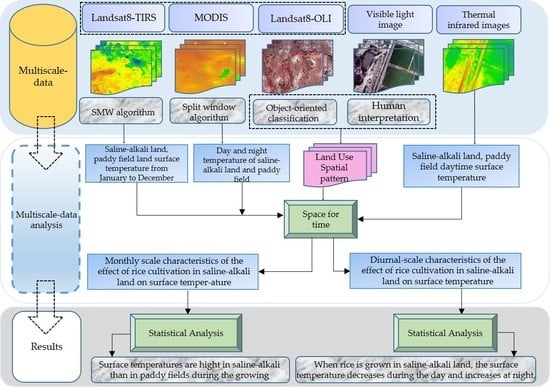Impact of Saline-Alkali Land Greening on the Local Surface Temperature—A Multiscale Assessment Based on Remote Sensing
Abstract
:1. Introduction
2. Materials and Methods
2.1. Overview of the Study Area
2.2. Data Sources
2.3. Method
2.3.1. Object-Oriented Classification
2.3.2. Land Surface Temperature (LST) Extraction
3. Results
3.1. Characteristics of Land Use Change from 2015 to 2021
3.2. Monthly Scale Characteristics of the Effect of Rice Cultivation in Saline–Alkali Land on Surface Temperature
3.3. Diurnal-Scale Characteristics of the Effect of Rice Planting in Saline–Alkali Land on Surface Temperature
3.4. Daytime LST Observations from UAVs
4. Discussions
4.1. Effects and Mechanism of Rice Cultivation in Saline–Alkali Land on Surface Temperature
4.2. Uncertainty Analysis of Remote-Sensing Multiscale Assessment of the Impact of Rice Cultivation in Saline–Alkali Land on Surface Temperature
5. Conclusions
Author Contributions
Funding
Data Availability Statement
Conflicts of Interest
Appendix A
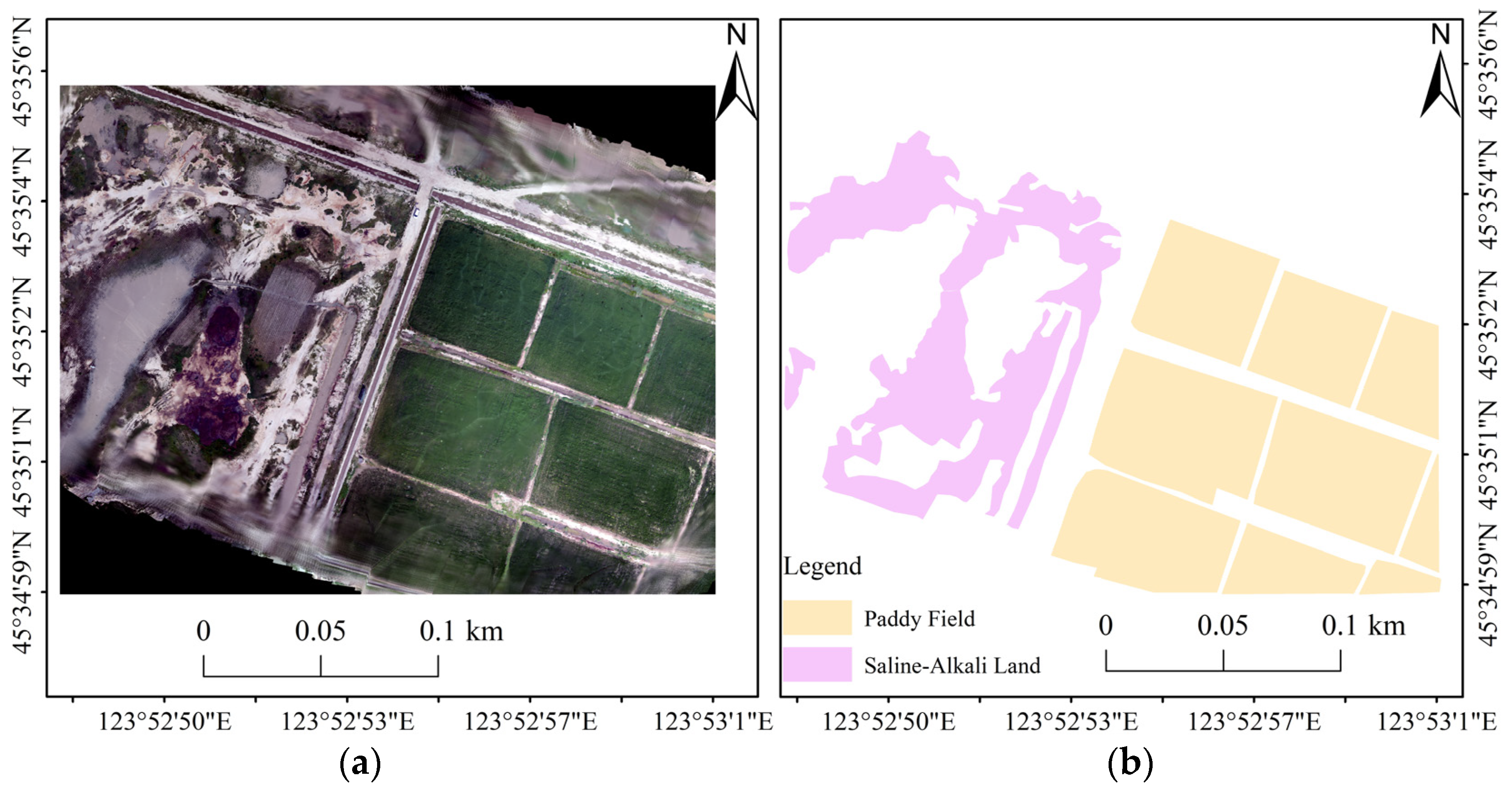
References
- FAO. Available online: http://www.fao.org/soils-portal/soil-management (accessed on 5 March 2022).
- Wang, Z. Problems of developing rice in the saline-alkali area of songnen plain. Territ. Nat. Resour. Study 1999, 51–52, 237–241. [Google Scholar] [CrossRef]
- Liu, T.; Yu, L.; Zhang, S. Land Surface Temperature Response to Irrigated Paddy Field Expansion: A Case Study of Semi-arid Western Jilin Province, China. Sci. Rep. 2019, 9, 5278. [Google Scholar] [CrossRef]
- Yu, L.X.; Yang, J.C.; Bu, K.; Liu, T.X.; Jiao, Y.; Li, G.S.; Pu, L.M.; Zhang, S.W. Impacts of Saline-Alkali Land Improvement on Regional Climate: Process, Mechanisms, and Implications. Remote Sens. 2021, 13, 3407. [Google Scholar] [CrossRef]
- Cramer, W.; Bondeau, A.; Woodward, F.I.; Prentice, I.C.; Betts, R.A.; Brovkin, V.; Cox, P.M.; Fisher, V.; Foley, J.A.; Friend, A.D.; et al. Global response of terrestrial ecosystem structure and function to CO2 and climate change: Results from six dynamic global vegetation models. Glob. Chang. Biol. 2001, 7, 357–373. [Google Scholar] [CrossRef]
- Pielke Sr, R.A.; Marland, G.; Betts, R.A.; Chase, T.N.; Eastman, J.L.; Niles, J.O.; Niyogi, D.D.S.; Running, S.W. The influence of land-use change and landscape dynamics on the climate system: Relevance to climate-change policy beyond the radiative effect of greenhouse gases. Philos. Trans. R. Soc. Lond. Ser. A Math. Phys. 2002, 360, 1705–1719. [Google Scholar] [CrossRef] [PubMed]
- Feddema, J.J.; Oleson, K.W.; Bonan, G.B.; Mearns, L.O.; Buja, L.E.; Meehl, G.A.; Washington, W.M.J.S. The importance of land-cover change in simulatingfutureclimates. Science 2005, 310, 1674–1678. [Google Scholar] [CrossRef]
- Chen, C.; Park, T.; Wang, X.H.; Piao, S.L.; Xu, B.D.; Chaturvedi, R.K.; Fuchs, R.; Brovkin, V.; Ciais, P.; Fensholt, R.; et al. China and India lead in greening of the world through land-use management. Nat. Sustain. 2019, 2, 122–129. [Google Scholar] [CrossRef]
- Peng, S.S.; Piao, S.; Zeng, Z.; Ciais, P.; Zhou, L.; Li, L.Z.; Myneni, R.B.; Yin, Y.; Zeng, H. Afforestation in China cools local land surface temperature. Proc. Natl. Acad. Sci. USA 2014, 111, 2915–2919. [Google Scholar] [CrossRef]
- Huang, L.; Zhai, J.; Liu, J.; Sun, C. The moderating or amplifying biophysical effects of afforestation on CO2-induced cooling depend on the local background climate regimes in China. Agric. For. Meteorol. 2018, 260, 193–203. [Google Scholar] [CrossRef]
- Zeng, Z.Z.; Piao, S.L.; Li, L.Z.X.; Wang, T.; Ciais, P.; Lian, X.; Yang, Y.T.; Mao, J.F.; Shi, X.Y.; Myneni, R.B. Impact of Earth Greening on the Terrestrial Water Cycle. J. Clim. 2018, 31, 2633–2650. [Google Scholar] [CrossRef]
- Zeng, Z.; Piao, S.; Li, L.Z.; Zhou, L.; Ciais, P.; Wang, T.; Li, Y.; Lian, X.; Wood, E.F.; Friedlingstein, P. Climate mitigation from vegetation biophysical feedbacks during the past three decades. Nat. Clim. Chang. 2017, 7, 432–436. [Google Scholar] [CrossRef]
- Li, Y.; Piao, S.; Chen, A.; Ciais, P.; Li, L.Z. Local and teleconnected temperature effects of afforestation and vegetation greening in China. Natl. Sci. Rev. 2020, 7, 897–912. [Google Scholar] [CrossRef] [PubMed]
- Li, Y.; Piao, S.; Li, L.Z.X.; Chen, A.; Wang, X.; Ciais, P.; Huang, L.; Lian, X.; Peng, S.; Zeng, Z.; et al. Divergent hydrological response to large-scale afforestation and vegetation greening in China. Sci. Adv. 2018, 4, eaar4182. [Google Scholar] [CrossRef]
- Yu, L.X.; Xue, Y.K.; Diallo, I. Vegetation greening in China and its effect on summer regional climate. Sci. Bull. 2021, 66, 13–17. [Google Scholar] [CrossRef]
- Zhang, Q.; Li, M.Y. Analysis of Dynamic Changes of Saline Alkali Land in Da’an CityBased on GIS and Remote Sensing. Geomat. Spat. Info Rmation Technol. 2019, 42, 65–68+72. [Google Scholar] [CrossRef]
- Li, X.Y.; Zhang, S.W. Tempo-Spatial Dynamics and Driving Factors of Saline-Alkali Land in Daan City of Jilin Province. Resour. Sci. 2005, 27, 92–97. [Google Scholar] [CrossRef]
- Xiang, Y.B.; Zhang, C.P.; Wu, Z.G.; Fu, C.D. Inversion Study on Chlorophyll a ofShahu Lake Based on Landsat 8 Data. Territ. Nat. Resour. Study 2022, 1, 88–91. [Google Scholar] [CrossRef]
- Wan, Z. New refinements and validation of the MODIS land-surface temperature/emissivity products. Remote Sens. Environ. 2008, 112, 59–74. [Google Scholar] [CrossRef]
- Cao, B.; Qin, Q.M.; Ma, H.J.; Qiu, Y.F. Research on Spatial Variability of Water Quality Parameter and Their Adequate Sampling Amountin Meiliang Bayouof TaihuLake. Geogr. Geo. Inf. Sci. 2006, 2, 50–54. [Google Scholar] [CrossRef]
- Ma, Y.G.; Li, H.; Xia, L. The Model for Extracting Information of Land Use/Land Cover Change; Xinjiang Remote Sensing Center: Urumqi, China, 2006; Volume 5, pp. 50–51+76. [Google Scholar] [CrossRef]
- Lu, C.Y.; Wang, Z.M.; Jia, M.M.; Zhang, J.; Man, W.D.; Mao, D.H. Peatland Extraction Based on ENVISAT ASAR, Landsat TM and DEM Data. Geomat. Inf. Sci. Wuhan Univ. 2016, 42, 48. [Google Scholar] [CrossRef]
- Duguay-Tetzlaff, A.; Bento, V.A.; Göttsche, F.M.; Stöckli, R.; Martins, J.; Trigo, I.; Olesen, F.; Bojanowski, J.S.; Da Camara, C.; Kunz, H. Meteosat land surface temperature climate data record: Achievable accuracy and potential uncertainties. Remote Sens. 2015, 7, 13139–13156. [Google Scholar] [CrossRef]
- Sun, D.; Pinker, R.T.; Basara, J.B. Land surface temperature estimation from the next generation of Geostationary Operational Environmental Satellites: GOES M–Q. J. Appl. Meteorol. Climatol. 2004, 43, 363–372. [Google Scholar] [CrossRef]
- Freitas, S.C.; Trigo, I.F.; Macedo, J.; Barroso, C.; Silva, R.; Perdigão, R. Land surface temperature from multiple geostationary satellites. Int. J. Remote Sens. 2013, 34, 3051–3068. [Google Scholar] [CrossRef]
- Li, Z.-L.; Tang, B.-H.; Wu, H.; Ren, H.; Yan, G.; Wan, Z.; Trigo, I.F.; Sobrino, J.A. Satellite-derived land surface temperature: Current status and perspectives. Remote Sens. Environ. 2013, 131, 14–37. [Google Scholar] [CrossRef]
- Ermida, S.L.; Soares, P.; Mantas, V.; Gottsche, F.M.; Trigo, I.E. Google Earth Engine Open-Source Code for Land Surface Temperature Estimation from the Landsat Series. Remote Sens. 2020, 12, 1471. [Google Scholar] [CrossRef]
- Yu, L.X.; Liu, Y.; Liu, T.X.; Yan, F.Q. Impact of recent vegetation greening on temperature and precipitation over China. Agric. For. Meteorol. 2020, 295, 108197. [Google Scholar] [CrossRef]
- Zhang, X.; Tang, Q.; Zheng, J.; Ge, Q. Warming/cooling effects of cropland greenness changes during 1982–2006 in the North China Plain. Environ. Res. Lett. 2013, 8, 024038. [Google Scholar] [CrossRef]
- Liu, T.X.; Yu, L.X.; Bu, K.; Yang, J.C.; Yan, F.Q.; Zhang, S.W.; Li, G.S.; Jiao, Y.; Liu, S.Z. Thermal and moisture response to land surface changes across different ecosystems over Heilong-Amur River Basin. Sci. Total Environ. 2022, 818, 151799. [Google Scholar] [CrossRef]
- Novick, K.A.; Katul, G.G. The duality of reforestation impacts on surface and air temperature. J. Geophys. Res. Biogeosci. 2020, 125, e2019JG005543. [Google Scholar] [CrossRef]
- Kelly Turner, V.; Rogers, M.L.; Zhang, Y.; Middel, A.; Schneider, F.A.; Ocón, J.P.; Seeley, M.; Dialesandro, J. More than surface temperature: Mitigating thermal exposure in hyper-local land system. J. Land Use Sci. 2022, 17, 79–99. [Google Scholar] [CrossRef]
- Cooley, H.S.; Riley, W.J.; Torn, M.S.; He, Y. Impact of agricultural practice on regional climate in a coupled land surface mesoscale model. J. Geophys. Res. Atmos. 2005, 110, D3. [Google Scholar] [CrossRef]
- Yu, L.X.; Liu, T.X.; Zhang, S.W. Temporal and Spatial Changes in Snow Cover and the Corresponding Radiative Forcing Analysis in Siberia from the 1970s to the 2010s. Adv. Meteorol. 2017, 2017, 9517427. [Google Scholar] [CrossRef]
- Friedlingstein, P.; Jones, M.; O’Sullivan, M.; Andrew, R.; Hauck, J.; Peters, G.; Peters, W.; Pongratz, J.; Sitch, S.; Le Quéré, C. Global Carbon Budget 2019. Earth Syst. Sci. Data 2019, 11, 1783–1838. [Google Scholar] [CrossRef]
- Shen, M.; Piao, S.; Jeong, S.J.; Zhou, L.; Zeng, Z.; Ciais, P.; Chen, D.; Huang, M.; Jin, C.S.; Li, L.Z.; et al. Evaporative cooling over the Tibetan Plateau induced by vegetation growth. Proc. Natl. Acad. Sci. USA 2015, 112, 9299–9304. [Google Scholar] [CrossRef]
- Yu, L.X.; Liu, Y.; Yang, J.C.; Liu, T.X.; Bu, K.; Li, G.S.; Jiao, Y.; Zhang, S.W. Asymmetric daytime and nighttime surface temperature feedback induced by crop greening across Northeast China. Agric. Forest Meteorol. 2022, 325, 109136. [Google Scholar] [CrossRef]
- Yang, C.B. The Effect of the Urban Spatial Structure on the Spatio-Temperal Patterns of the Urban Thermal Environment. Ph.D. Thesis, Northeast Institute of Geography and Agroecology Chinese Academy of Sciences, Changchun, China, 2018. [Google Scholar]
- Kuai, Y.; Wang, B.; Wu, Y.L.; Chen, X.D.; Xue, W.B. Urban Vegetation Classification based on Multi-scale Feature Perception Network forUAV Images. J. Geo-Inf. Sci. 2022, 24, 962–980. [Google Scholar] [CrossRef]
- Tian, H.H.; Feng, L.; Zhao, M.M.; Guo, S.; Dong, J. Analysis of Meticulous Features of Urban Surban Surban Surface Temperaturebased on UAV Thermal Thermography. Remote Sens. Technol. Appl. 2019, 34, 553–563. [Google Scholar] [CrossRef]
- Carlson, T.N.; Ripley, D.A. On the relation between NDVI, fractional vegetation cover, and leaf area index. Remote Sens. Environ. 1997, 62, 241–252. [Google Scholar] [CrossRef]
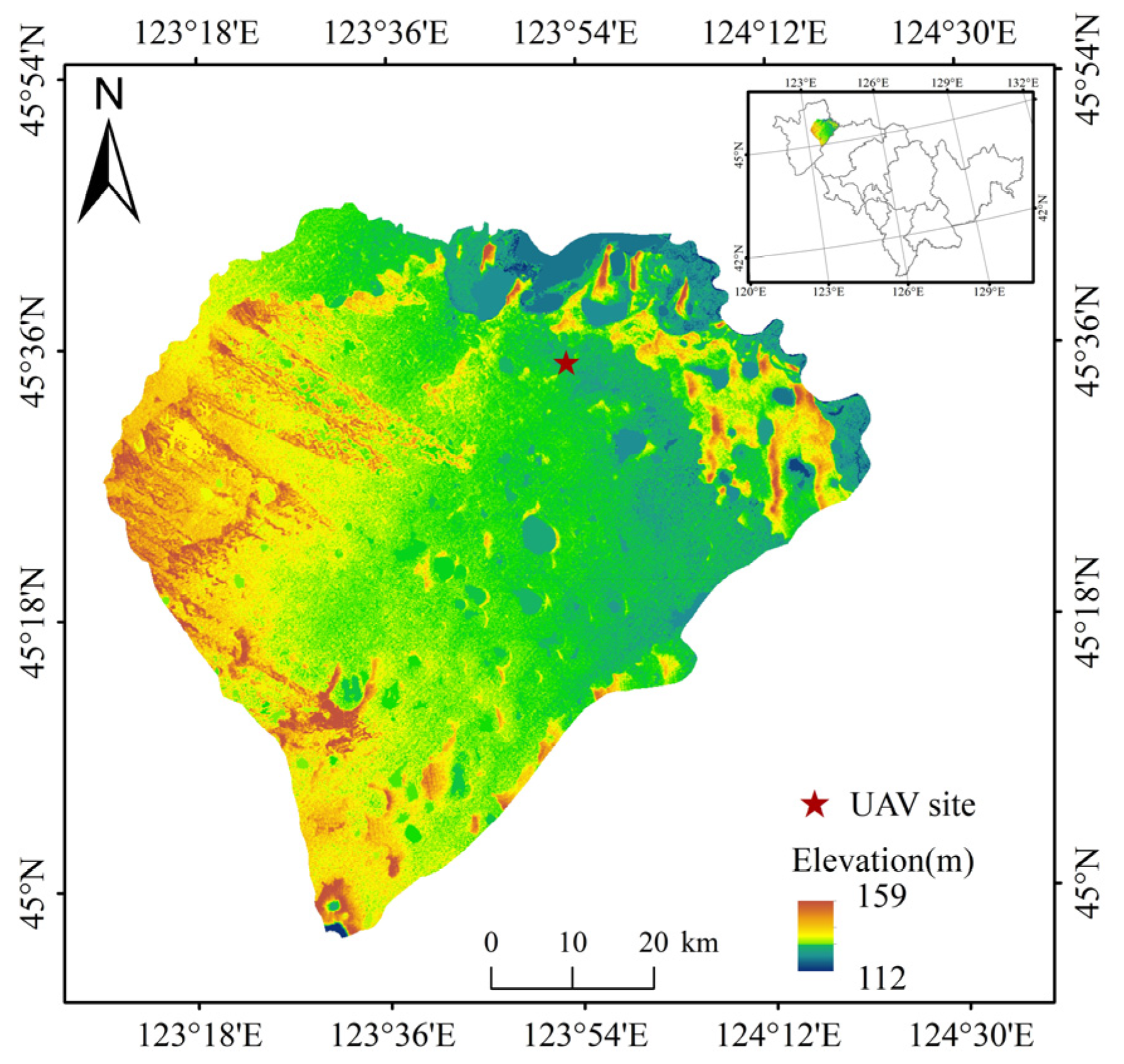
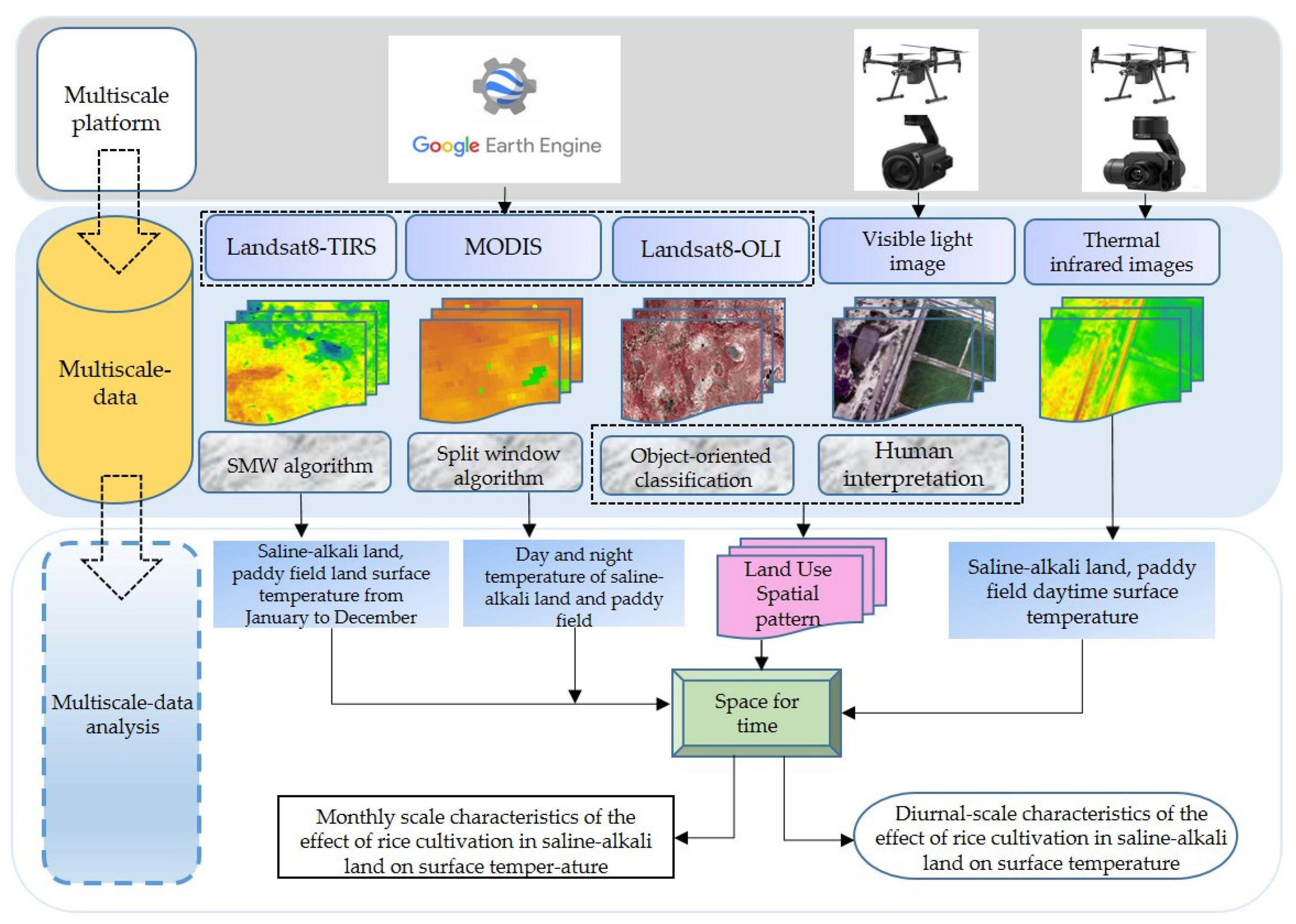
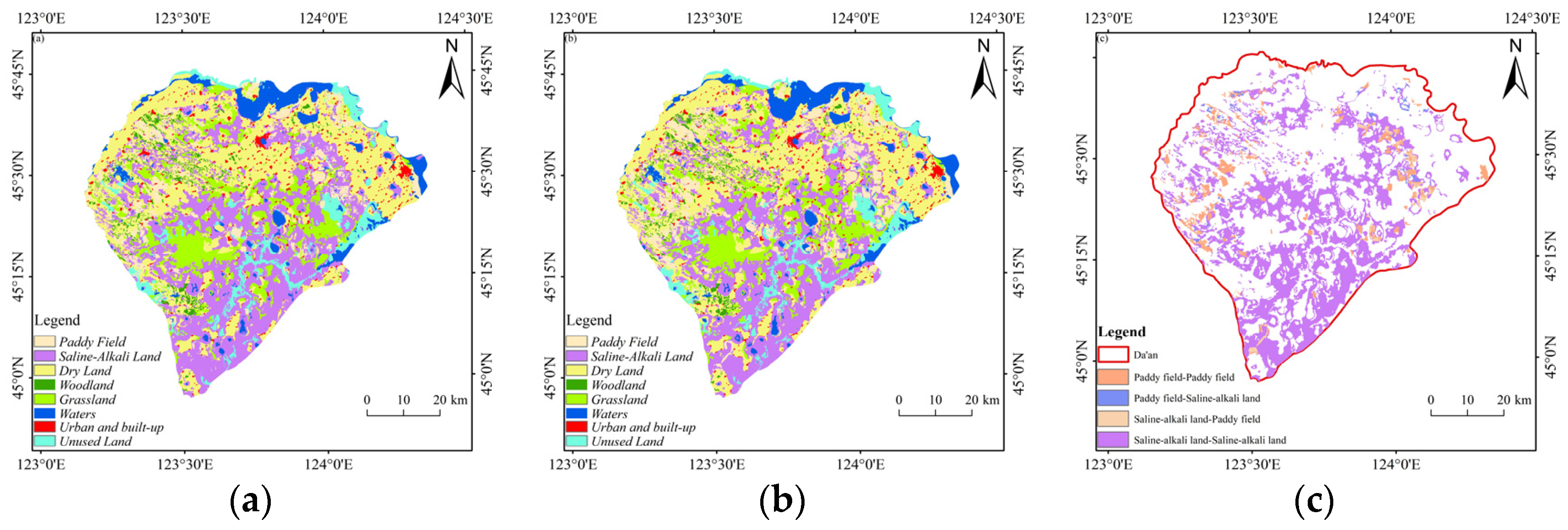
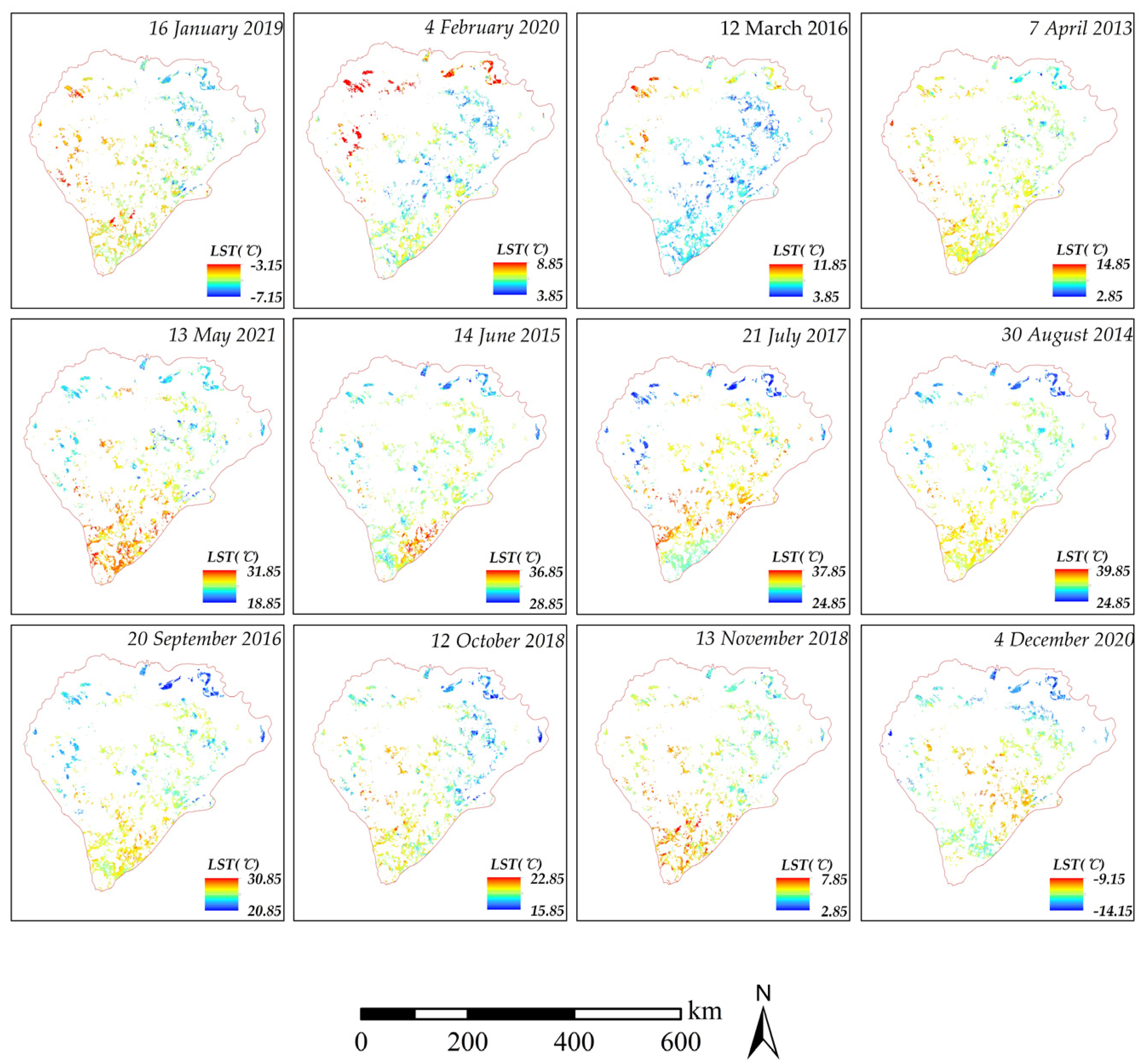

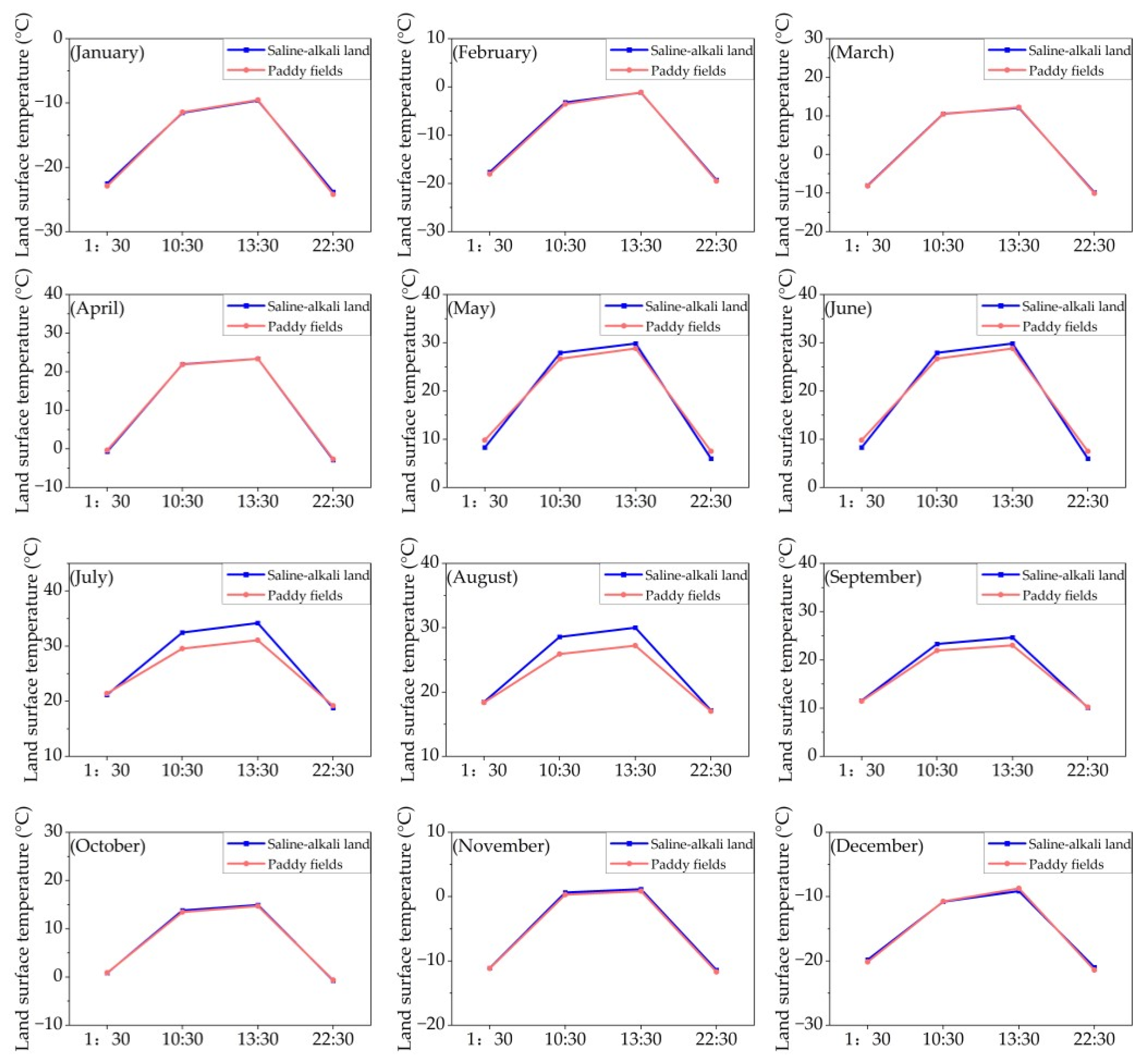
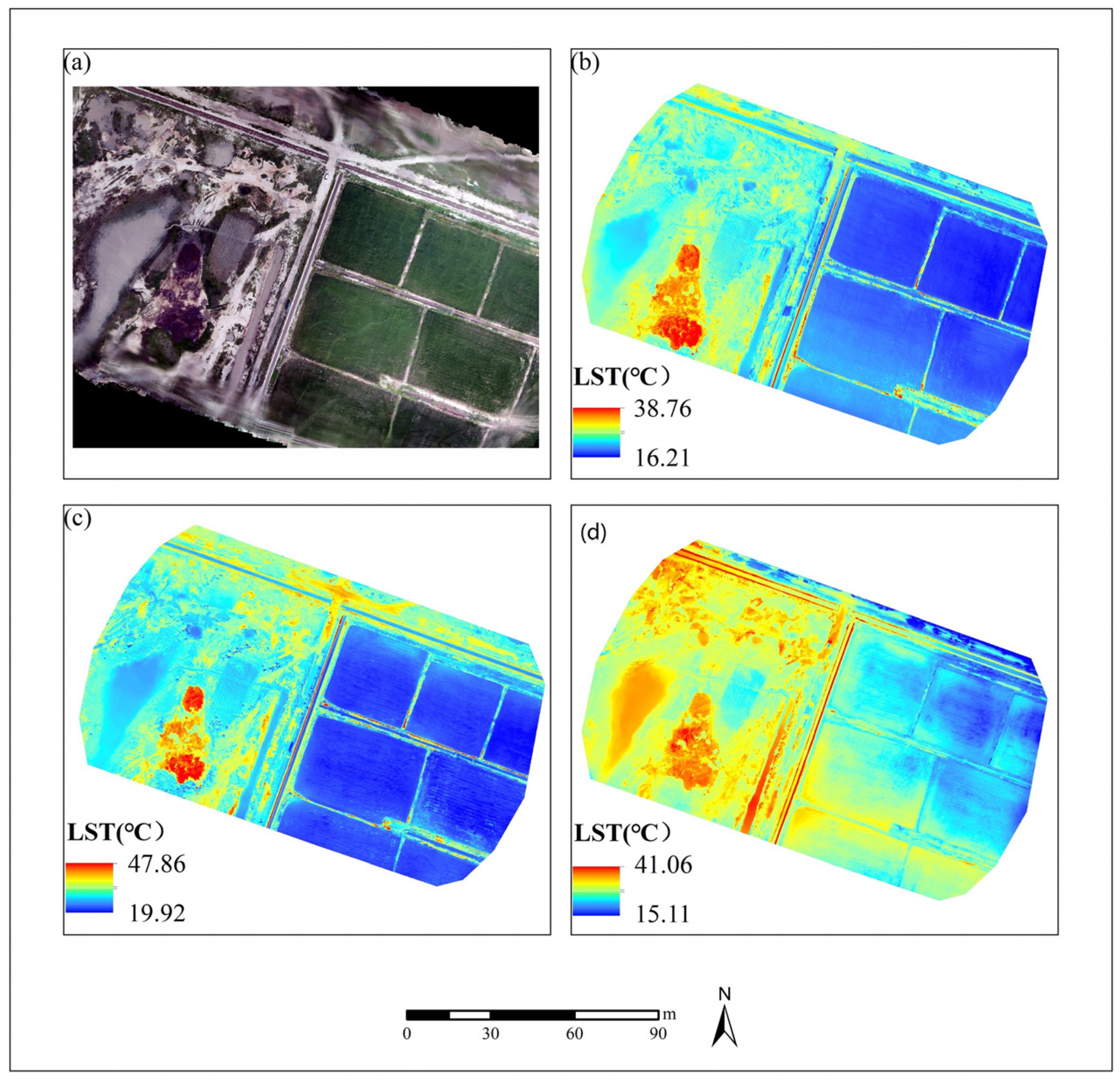
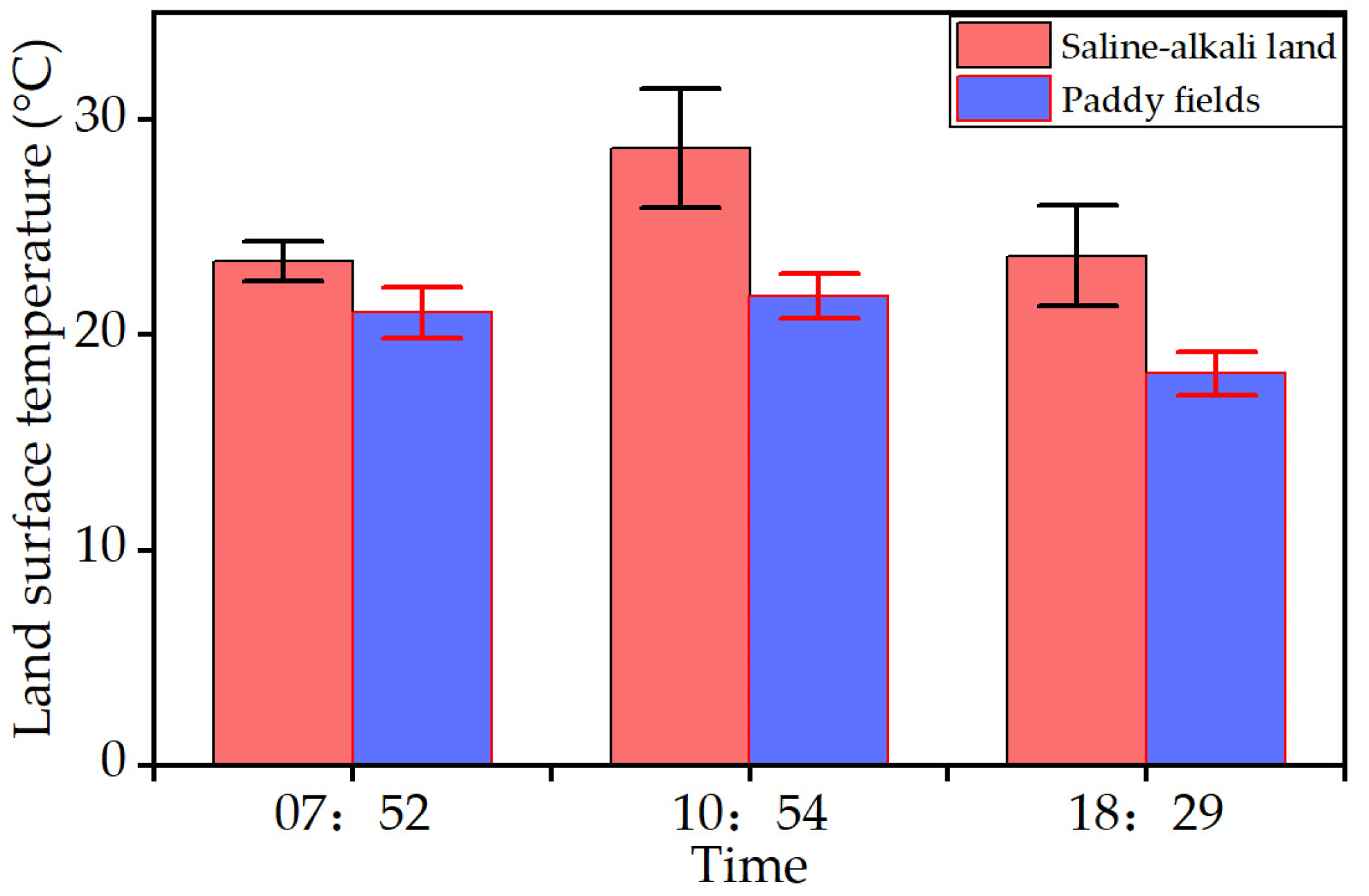
| Sensor | Landsat 8 OLI/TIR |
|---|---|
| Track Number | Overpass Time |
| 120/028 (029) | 7 April 2013, 30 August 2014, 14 June 2015, 12 March 2016, 20 September 2016, 21 July 2017, 12 October 2018, 13 November 2018, 16 January 2019, 4 February 2020, 4 December 2020, 13 May 2021 |
| Name | May | June | July | August | September | October |
|---|---|---|---|---|---|---|
| Saline–Alkali Land LST | 28.30 | 33.97 | 33.95 | 34.22 | 27.24 | 20.15 |
| Paddy Field LST | 23.71 | 31.83 | 28.35 | 29.36 | 23.69 | 18.54 |
| temperature difference | 4.59 | 2.15 | 5.60 | 4.86 | 3.55 | 1.61 |
| TIME | January | February | March | April | May | June | July | August | September | October | November | December | The Annual Average | Growing Season Average |
|---|---|---|---|---|---|---|---|---|---|---|---|---|---|---|
| Surface temperature difference between saline–alkali land and paddy fields (°C) | ||||||||||||||
| 10:30 a.m. | −0.07 | 0.30 | 0.04 | 0.06 | 1.25 | 1.96 | 2.91 | 2.67 | 1.35 | 0.34 | 0.36 | −0.05 | 0.93 | 1.75 |
| 13:30 p.m. | −0.11 | −0.08 | −0.17 | 0.00 | 0.99 | 1.83 | 3.09 | 2.76 | 1.64 | 0.25 | 0.26 | −0.43 | 0.84 | 1.76 |
| 1:30 a.m. | 0.38 | 0.44 | 0.15 | −0.37 | −1.54 | −1.33 | −0.27 | 0.08 | 0.10 | −0.07 | 0.03 | 0.36 | −0.17 | −0.51 |
| 22:30 p.m. | 0.38 | 0.22 | 0.24 | −0.23 | −1.50 | −1.54 | −0.41 | 0.13 | −0.10 | −0.16 | 0.29 | 0.42 | −0.19 | −0.60 |
| Average temperature difference during the day | −0.09 | 0.11 | −0.06 | 0.03 | 1.12 | 1.89 | 3.00 | 2.72 | 1.49 | 0.30 | 0.31 | −0.24 | 0.88 | 1.75 |
| Average temperature difference at night | 0.38 | 0.33 | 0.19 | −0.30 | −1.52 | −1.43 | −0.34 | 0.10 | 0.00 | −0.11 | 0.16 | 0.39 | −0.18 | −0.55 |
| Average daily temperature difference | 0.14 | 0.22 | 0.06 | −0.14 | −0.20 | 0.23 | 1.33 | 1.41 | 0.75 | 0.09 | 0.24 | 0.07 | 0.35 | 0.60 |
| Name | 07:52 | 10:54 | 18:29 |
|---|---|---|---|
| Saline–alkali land LST | 23.41 | 28.68 | 23.68 |
| Paddy field LST | 21.04 | 21.81 | 18.22 |
| Temperature difference | 2.37 | 6.88 | 5.45 |
Publisher’s Note: MDPI stays neutral with regard to jurisdictional claims in published maps and institutional affiliations. |
© 2022 by the authors. Licensee MDPI, Basel, Switzerland. This article is an open access article distributed under the terms and conditions of the Creative Commons Attribution (CC BY) license (https://creativecommons.org/licenses/by/4.0/).
Share and Cite
Xin, B.; Yu, L.; Li, G.; Jiao, Y.; Liu, T.; Zhang, S.; Lei, Z. Impact of Saline-Alkali Land Greening on the Local Surface Temperature—A Multiscale Assessment Based on Remote Sensing. Remote Sens. 2022, 14, 4246. https://doi.org/10.3390/rs14174246
Xin B, Yu L, Li G, Jiao Y, Liu T, Zhang S, Lei Z. Impact of Saline-Alkali Land Greening on the Local Surface Temperature—A Multiscale Assessment Based on Remote Sensing. Remote Sensing. 2022; 14(17):4246. https://doi.org/10.3390/rs14174246
Chicago/Turabian StyleXin, Bingxia, Lingxue Yu, Guangshuai Li, Yue Jiao, Tingxiang Liu, Shuwen Zhang, and Zhongying Lei. 2022. "Impact of Saline-Alkali Land Greening on the Local Surface Temperature—A Multiscale Assessment Based on Remote Sensing" Remote Sensing 14, no. 17: 4246. https://doi.org/10.3390/rs14174246
APA StyleXin, B., Yu, L., Li, G., Jiao, Y., Liu, T., Zhang, S., & Lei, Z. (2022). Impact of Saline-Alkali Land Greening on the Local Surface Temperature—A Multiscale Assessment Based on Remote Sensing. Remote Sensing, 14(17), 4246. https://doi.org/10.3390/rs14174246










